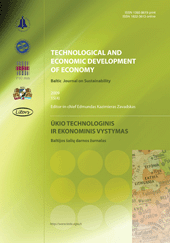Alterations in the Financial Markets of the Baltic Countries and Russia in the Period of Economic Downturn
Alterations in the Financial Markets of the Baltic Countries and Russia in the Period of Economic Downturn
Author(s): Stanislava Stungurienė, Petras DubinskasSubject(s): Economy
Published by: Vilnius Gediminas Technical University
Keywords: financial markets; financial crisis; Granger causality test; empiric test; general trends
Summary/Abstract: The present article analyses the alternations in the causality in the financial markets during the 2008-2009 financial crisis with a clear focus on the changes and developments in the financial markets of the Baltic States and Russia in the period starting from 2008. The authors have advanced a hypothesis that the research methods of trends of an abrupt plunge and subsequent stabilistation of equity prices that were clearly discernable during the 1987 crisis are also pointfull for the current financial crisis. The present research was conducted on the basis of the following assumptions: both crises affected financial markets of several nations; a characteristic feature for the inception of the crises is an abrupt fall in equity prices; indications of stabilisation in financial markets become observable before financial experts conclude the end of the financial crisis. To confirm the hypothesis on the similarities of the general trends during the two major international financial crisis, the authors employed empiric tests developed on the basis of Granger causality tests. Based on the precedent survey of the financial crisis of 1987 (Malliaris and Urrutia 1992), the authors of the present article chose to use the Granger causality testing methodology. To be able to apply the Granger causality test first it was necessary to verify the degree of cointegration of the indices of the main equity markets in each of the country (OMX Vilnius, OMX Riga, OMX Tallinn, RTS). For that purpose the authors used the Dickey-Fuller and Johansen testing methodology. Both methodologies demonstrated a strong cointegration between the changes in the indices of all equity markets irrespective of the period analysed (i.e., pre-crisis, during the crisis, post-crisis). In all cases the T-statistics exceeded the critical value. The strongest cointegration was observable in the crisis period, and the weakest – after the crisis. The results showed that in view of the financial crisis the Latvian market showed the greatest degree of slow-down despite it being most active in the pre-crisis times, likewise, Estonian market also showed a somewhat higher degree of passiveness. Thus, it was the Latvian and Estonian markets that the financial downturn had the most painful impacts upon. While the Lithuanian and the Russian markets were, on the contrary, much more active and therefore outlived the equity crash period with least painful after-effects, thus producing confirmation that in the face of a crisis the interests and expectations of most investors are largely related to major markets normally viewed as more reliable and showing a higher degree of resilience.
Journal: Technological and Economic Development of Economy
- Issue Year: 2010
- Issue No: 3
- Page Range: 502-515
- Page Count: 14
- Language: English

